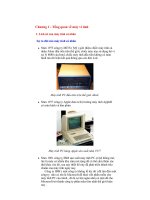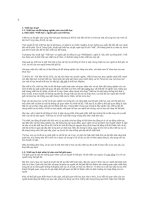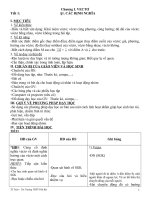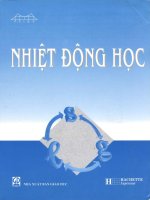Tad1640 ve
Bạn đang xem bản rút gọn của tài liệu. Xem và tải ngay bản đầy đủ của tài liệu tại đây (29.99 MB, 362 trang )
<span class="text_page_counter">Trang 1</span><div class="page_container" data-page="1">
Group 21-26
<b>Workshop Manual</b>
TAD1640-42GE, TAD1641-43VE, TAD1650-51GE, TAD1640-42VE-B, TAD1650VE, TAD1650VE-B,
TAD1651VE, TAD1660-62VE, TAD1670-72VE, TWD1643GE, TWD1652-53GE, TWD1663GE,
TWD1672-73GE
</div><span class="text_page_counter">Trang 3</span><div class="page_container" data-page="3"><b>20-0 Engine Information, General ... 57</b>
<b>Design and Function ... 57</b>
<b>Troubleshooting ... 88</b>
<b>Test and Adjustments ... 93</b>
<b>Engine21-0 Engine Complete, General ... 106</b>
<b>Exposing the Engine ... 155</b>
<b>Fitting the Fixture ... 162</b>
<b>Engine Disassembly ... 163</b>
<b>Engine Assembly ... 207</b>
<b>21-4 Valve Mechanism ... 209</b>
<b>Lubricating and Oil System22-0 Lubricating and Oil System, General ... 224</b>
<b>22-1 Oil pump and Line ... 225</b>
<b>22-2 Oil filter ... 226</b>
<b>22-3 Oil cooler ... 233</b>
<b>Fuel System23-0 Fuel System, General ... 236</b>
<b>23-3 Fuel Feed Pump and Filter ... 240</b>
<b>23-7 Injectors and Delivery Pipes ... 243</b>
<b>23-8 Control System, ECM, Data Sets ... 247</b>
<b>Inlet and Exhaust System25-0 Inlet and Exhaust System, General ... 249</b>
<b>25-2 Exhaust Pipe, Silencer ... 250</b>
<b>25-5 Turbo and supercharger ... 252</b>
<b>25-8 Emission After-Treatment ... 267</b>
<b>Cooling System26-0 Cooling System, General ... 323</b>
</div><span class="text_page_counter">Trang 4</span><div class="page_container" data-page="4"><b>26-5 Charge Air Cooler with Connections ... 342</b>
<b>Alternator, Charge Regulator</b>
</div><span class="text_page_counter">Trang 5</span><div class="page_container" data-page="5"><b>About this Workshop manual</b>
<b>General information</b>
This Service Manual contains technical data, descrip-tions and maintenance and repair instrucdescrip-tions for standard model Volvo Penta products. A list of these
<i><b>products may be found in the section Specifica-tions.</b></i>
The product designation and the serial number and specification is indicated on the engine decal or type plate. This information must be included in all corre-spondence regarding the product.
The service manual is produced primarily for the use of Volvo Penta workshops and their qualified person-nel. It is assumed that any person using the Service Manual has a fundamental knowledge of the product and is able to carry out mechanical and electrical work to trade standard.
Volvo Penta continually develops its products; we therefore reserve the right to make changes. All infor-mation in this manual is based on product data which was available up to the date on which the manual was printed. New working methods and significant changes introduced to the product after this date are
<i><b>communicated in the form of Service bulletins.</b></i>
<b>Spare Parts</b>
Spare parts for the electrical and fuel systems are subject to various national safety standards. Volvo Penta Original Spare Parts meet these standards. No damage of any kind caused by the use of spare parts not approved by Volvo Penta will be compensated by any warranty undertaking.
<b>Certified engines</b>
<b>When carrying out service and repair on emis-sion-certified engines, it is important to be awareof the following:</b>
Certification means that an engine type has been inspected and approved by the relevant authority. The engine manufacturer guarantees that all engines of the same type are manufactured to correspond to the certified engine.
This places special demands on service and repair work, namely:
• Maintenance and service intervals recom-mended by Volvo Penta must be complied with. • Only spare parts approved by Volvo Penta may
be used.
• Service on injection pumps, pump settings and injectors must always be carried out by an authorized Volvo Penta workshop.
• The engine must not be converted or modified, except with accessories and service kits which Volvo Penta has approved for the engine. • No changes to the exhaust pipe and engine air
inlet duct installations may be made.
• No warranty seals (where present on the prod-uct) may be broken by unauthorized persons. The general instructions in the Operator's Manual concerning operation, service and maintenance apply.
Neglected or poorly-performed care/service and the use of spare parts not approved by Volvo Penta, will mean that AB Volvo Penta no longer guarantees that the engine conforms to the certified model.
Volvo Penta accepts no responsibility for damage or costs arising as a result of failure to follow the above mentioned standards.
</div><span class="text_page_counter">Trang 6</span><div class="page_container" data-page="6"><b>Repair instructions</b>
The working methods described in this manual are based on a workshop scenario where the product is mounted in a holding fixture. Maintenance work is often carried out on site, in which case – if nothing else is indicated – using the same working methods as the workshop.
Warning symbols that occur in the service manual.
<i><b>For significance, refer to Safety Information .</b></i>
<b>IMPORTANT!, NOTICE!</b>
are by no means comprehensive since not everything can be foreseen as service work is carried out in the most varied of circumstances. We call attention to risks that may occur due to incorrect handling during work in a well-equipped workshop using working methods and tools tried and tested by us.
The service manual describes work operations car-ried out with the aid of Volvo Penta Special Tools, where such have been developed. Volvo Penta Spe-cial Tools are designed to ensure the safest and most rational working methods possible. It is therefore the responsibility of anyone using tools or working meth-ods other than those we recommend to ensure that no risk of personal injury or mechanical damage is present, or that malfunction can result.
In some cases, special safety regulations and user instructions may be in force for the tools and chemi-cals mentioned in the Service Manual. These regu-lations must always be followed, and no special instructions regarding this are to be found in the Serv-ice Manual.
By taking these basic precautions and using common sense it will be possible to guard against most ele-ments of risk. A clean workplace and a clean product will eliminate many risks of personal injury and mal-function.
Above all, when working on fuel systems, hydraulic systems, lubrication systems, turbochargers, inlet systems, bearings and seals, it is of the utmost impor-tance that dirt and foreign objects are kept away, as malfunctions or shortened service intervals may
<b>oth-Our mutual responsibility</b>
Each product comprises a large number of interacting systems and components. A deviation from the tech-nical specification may dramatically increase the environmental impact of an otherwise reliable sys-tem. It is therefore critical that the stated wear toler-ances be adhered to, that systems which can be adjusted be correctly set up and that only Volvo Penta Original Parts are used. The intervals in the care and maintenance schedule must be followed.
Some systems, e.g. fuel systems, often require spe-cial expertise and test equipment. A number of com-ponents are factory-sealed, for among other things environmental reasons. Warranty-sealed compo-nents may not be worked on without authorization to perform such work.
Remember that most chemical products, incorrectly used, are harmful to the environment. Volvo Penta recommends the use of biodegradable degreasers whenever components are cleaned, unless otherwise specified in the Service Manual. When working out-doors, take especial care to ensure that oils and wash residues etc. are correctly properly for destruction.
<b>Tightening torques</b>
Tightening torques for vital fasteners that must be applied using a torque wrench are indicated in the
<i><b>Service Manual, chapter Tightening torques and in</b></i>
the Manual's work descriptions. All torque indications apply to clean threads, bolt heads and mating faces. Indicated torque data apply to lightly-oiled or dry threads. If lubricants, locking fluids or sealants are required for fasteners, the correct type will be noted in the job description.
<b>Torque, angle tightening</b>
When torque/angle tightening, the fastener is tight-ened to a specified torque, and tightening then con-tinues through a pre-determined angle.
Example: For 90° angle tightening, the fastener is turned a further 1/4 turn in one sequence, after the specified tightening torque has been achieved.
</div><span class="text_page_counter">Trang 7</span><div class="page_container" data-page="7"><b>Lock nuts</b>
Removed locknuts may not be re-used; they must be replaced by new ones, as locking properties are impaired or lost with re-use.
In the case of lock nuts with plastic inserts the tight-ening torque indicated must be reduced if the nut has the same nut height as a standard, all-metal hexag-onal nut.
Reduce the torque by 25% for bolt sizes of 8 mm or larger.
In the case of lock nuts with plastic inserts with a high nut-height (where the all-metal thread is as high as a standard hexagonal nut), the indicated torque applies.
<b>Strength classes</b>
Nuts and bolts are subdivided into different strength classes. The classification is shown by a marking on the bolt head. Markings of a higher number indicate stronger material. For example, a bolt marked 10-9 is stronger than one marked 8-8.
For this reason, it is important that when bolts are removed they are returned to their original locations on re-assembly. When replacing bolts check the
<i><b>applicable Spare parts catalogue to ensure the </b></i>
cor-rect bolt is used.
<b>Sealing compounds etc.</b>
To ensure service work is correctly carried out it is important that the correct type of sealants and locking fluids are used on joints where such are required. In each service manual section concerned, the seal-ants used in product manufacture are indicated. The same sealants, or sealants with equivalent proper-ties, must be used for maintenance work.
Make sure that mating surfaces are dry and free from oil, grease, paint and anti-corrosion agent before applying sealant or locking fluid. Always follow the manufacturer's instructions regarding applicable temperatures, hardening times and such. Two basic types of compound are used:
<b>RTV preparations (Room Temperature Vulcaniz-ing).</b>
Used most often together with gaskets, e.g. sealing gasket joints, or are brushed on gaskets. RTV seal-ants are completely visible when the part has been removed. Old RTV sealant must be removed before the component is sealed again. Use denatured alco-hol.
<b>Anaerobic agents.</b>
These agents cure (harden) in the absence of air. These preparations are used when two solid compo-nents, e.g. two cast compocompo-nents, are fitted together without a gasket. Common uses are also to lock and seal plugs, stud threads, taps, oil pressure monitors etc.
Hardened anaerobic preparations are glassy and for this reason, the preparations are colored to make them visible. Hardened anaerobic preparations are highly resistant to solvents, and old compound can-not be removed. On re-assembly, it is important to carefully degrease and wipe dry components first, before applying new sealant in accordance with the instructions.
<b>Safety regulations for fluorocarbonrubber</b>
Fluorocarbon rubber is a common material in sealing rings for shafts, and in O-rings, for example.
When fluorocarbon rubber is exposed to high tem-peratures (above 300°C/572°F), hydrofluoric acid can form. This is highly corrosive. Contact with the skin can result in severe chemical burns. Splashes in your eyes can result in chemical wounds. If you breathe in the fumes, your lungs can be permanently damaged.
<b> WARNING!</b>
Seals must never be cut with a torch, or be burnt afterwards in an uncontrolled manner. Risk for poisonous gases.
<b> WARNING!</b>
Always use chloroprene rubber gloves (gloves for chemicals handling) and goggles. Handle the removed seal in the same way as corrosive acid. All residue, including ash, can be highly corrosive. Never use compressed air to blow clean.
Put the remains in a plastic container, seal it and apply a warning label. Wash the gloves under running water before removing them.
The following seals are most probably made from flu-orocarbon rubber:
Seal rings for the crankshaft, camshaft, idler shafts. rings, regardless of where they are installed. O-rings for cylinder liner sealing are almost always made of fluorocarbon rubber.
<b>Please note that seals which have not beenexposed to high temperature can be handled nor-mally.</b>
</div><span class="text_page_counter">Trang 8</span><div class="page_container" data-page="8">A lot of illustrations contains standardized symbols and colors. Please refer to the following information to reduce misunderstandings when working on an engine / transmission using this Workshop Manual.
<b>Illustration colors</b>
Most illustrations have a focused component (blue) which is fastened by a (red) bolt or such on a (light grey) engine / transmission body.
Focus arrows pointing at object. Sometimes it con-tains number of items, e.g. three bolts.
<b>NOTICE! If an arrow with the text “x3” is pointing at</b>
only one item, e.g. a bolt, it still applies to the other two alike items (the two other bolts) highlighted in the illustration.
This symbol gives a positioning number to an object, e.g. 2, which is also mentioned in the supplied text information.
The symbol to the left shows part no. of the positioned special tool, e.g. 9991801.
The symbol on the right side is used when something needs to be replaced by a new part / kit.
</div><span class="text_page_counter">Trang 9</span><div class="page_container" data-page="9">Movement arrows are used to show which direction a component is to be moved / rotated.
Symbol is used in a corner of the illustration to show how many degrees the object shall be turned and at which direction.
Symbol is used to show how many revolutions the object shall be turned and at which direction.
One of the following symbols is used when describing the recommended type of screwdriver.
<b>Tools (continuence)</b>
A symbol of a tool in a corner of the illustration is shown when the tool is recommended to use, e.g. a knife or a crowbar.
A drill in a specified size, duck tape and stripes may also be shown as symbols.
</div><span class="text_page_counter">Trang 10</span><div class="page_container" data-page="10">The scraper symbol suggests that a contact surface needs to be scraped from sealant etc.
The cloth symbol suggests that the mechanic should clean the contact surface thoroughly or be prepared for some oil spill or similar.
The tube symbol shows how thick layer of sealant to applicate.
The clock symbol is used when something needs to be done within or after a certain time.
Units are mentioned in the illustration when a specific value (e.g. pressure, weight or resistance etc.) is expected.
The eye symbol is used when something needs close inspection or must be performed in a certain way. The symbol to the right is used when several mechan-ics are needed.
<b>Safety</b>
</div><span class="text_page_counter">Trang 11</span><div class="page_container" data-page="11"><b>03-0 General Specifications</b>
</div><span class="text_page_counter">Trang 12</span><div class="page_container" data-page="12"><b>Engine designationTAD1641VETAD1642VE,TAD1643VE</b>
Cylinder volume, liter (inch<sup>3</sup>) <sup>16,12 (983.9)</sup>
</div><span class="text_page_counter">Trang 13</span><div class="page_container" data-page="13"><b>03-2 Specifications, Engine</b>
<b>General Tightening Torques</b>
<b>General Tightening Torques</b>
Check bolts which are to be re-installed. Damaged bolts, e.g. with shear marks under heads must be scrapped.
</div><span class="text_page_counter">Trang 14</span><div class="page_container" data-page="14"><b>Special Tightening TorquesGroup 21: Engine</b>
Main bearing caps
Big end bearing cap
</div><span class="text_page_counter">Trang 15</span><div class="page_container" data-page="15">Make sure the flange is clean and dry.
<b>NOTICE! Tighten the bolts in sequence, as illustrated.</b>
<b>Flywheel Housing</b>
<b>NOTICE! Apply 2 mm (0.08") silicone (part nos. 1161231 and 1161277) as illustrated.</b>
</div><span class="text_page_counter">Trang 16</span><div class="page_container" data-page="16"><b>Vibration Damper, Crankshaft</b>
<b>NOTICE! Tighten the bolts in sequence, as illustrated.</b> 90 ± 10 Nm (66.38 ± 7.38 lbf ft)
<b>NOTICE! The 8.8 bolts on the oscillation damper may not</b>
stage 1: Tighten all bolts by hand.
</div><span class="text_page_counter">Trang 18</span><div class="page_container" data-page="18"><b>Bearing Caps, Camshaft/Rocker ArmShaft, to engine nos. through 2016010024</b>
Tighten the bolts in stages to ensure that the rocker arm shaft lowers without being bent.
<b>stage 3: Tighten bolts 8 through 14. Begin with bolt 11.</b> 100 ± 10 Nm (73.76 ± 7.38 lbf ft)
</div><span class="text_page_counter">Trang 19</span><div class="page_container" data-page="19"><b>Bearing Caps, Camshaft/Rocker ArmShaft, from, and including, engine no.</b>
Tighten the bolts in stages to ensure that the rocker arm shaft bottoms against the bearing housing without bending.
If the rocker arm shaft has been loosened or removed, only the bolts that hold the shaft must be tightened in accordance with the chart on re-assembly.
<b>Camshaft (camshaft and bearing caps in place).</b>
Fit a drift to no. 7 bearing bracket (to protect the guide sleeve).
<b>stage 2: (with shorter extra bolts). Tighten bolts 8</b>
Remove the extra bolts 8 through 13. Remove the drift from no. 7 bearing bracket.
<b>Rocker arm shaft (rocker arm shaft in place)</b>
<b>stage 4: Tighten bolts 8 through 13 in stages in the order</b>
Loosen bolts 8 through 13.
</div><span class="text_page_counter">Trang 20</span><div class="page_container" data-page="20"><b>stage 9: Tighten bolts 8 through 13</b> 50 ± 5 Nm (36.88 ± 3.69 lbf ft)
<b>Timing gear plate</b>
<b>NOTICE! Apply 2 mm (0.08") silicone (part nos. 1161231</b>
and 1161277) to the back of the engine block as illustrated.
<b>NOTICE! Tighten the bolts in sequence, as illustrated.</b>
</div><span class="text_page_counter">Trang 21</span><div class="page_container" data-page="21"><b>2 Intermediate gear, bull drive, outer</b>
Tighten the bolts in sequence, as illustrated.
<b>3 Intermediate gear, adjustable</b>
Tighten the bolts in sequence, as illustrated.
<b>4 Drive gear, camshaft</b>
Tighten the bolts in sequence, as illustrated.
<b>5 Drive gear, steering servo and fuel feed pump</b> 100 ± 10 Nm (73.76 ± 7.38 lbf ft)
</div><span class="text_page_counter">Trang 22</span><div class="page_container" data-page="22"><b>Valve mechanism, VCB / EGR</b>
<b>Adjustment, VCB/EGR rocker (2) 52 Nm (38.4 lbf. ft.)Adjustment, exhaust tappet (3)</b> 38 Nm (28.0 lbf. ft.)
</div><span class="text_page_counter">Trang 23</span><div class="page_container" data-page="23"><b>Group 22: Lubrication System</b>
<b>Oil cooler, retaining bolts</b>
<b>NOTICE! Tighten the bolts in sequence, as illustrated.</b> 24 ± 4 Nm (19.91 ± 2.95 lbf ft)
<b>Oil pressure pipe</b>
</div><span class="text_page_counter">Trang 25</span><div class="page_container" data-page="25"><b>Group 23: Fuel System</b>
1 Copper sleeve, earlier model
2 Copper sleeve, earlier model (only ever available as factory fit, not as spare part) 3 Copper sleeve, new model
Fixing yoke, unit injector (new or re-used copper sleeve type 3)
<b>Always use a new steel gasket beneath the unit injector.</b>
First tightening
<b>NOTICE! Loosen the fixing yoke bolt before doing the second tightening.</b>
Second tightening
Fixing yoke, unit injector (re-used copper sleeve, types 1 or 2)
<b>NOTICE! The steel gasket must never be used under the unit injector.</b>
Locknut for adjuster screw, unit injector
Lock nut, valve adjusting
</div><span class="text_page_counter">Trang 26</span><div class="page_container" data-page="26"><b>Group 25: Inlet and Exhaust System</b>
<b>Intake manifold</b>
<b>NOTICE! Apply a 2 mm (approx 0.08") bead of sealing </b>
</div><span class="text_page_counter">Trang 27</span><div class="page_container" data-page="27"><b>TWD1643GE, TWD1652GE, TWD1653GE,TWD1663GE, TWD1672GE, TWD1673GE</b>
<b>Other engines</b>
<b>Turbo – exhaust manifold</b>
<b>Turbo – wastegate valve housing (only TWD)</b>
</div><span class="text_page_counter">Trang 28</span><div class="page_container" data-page="28"><b>Group 26: Cooling System</b>
<small>P0020409</small>
</div><span class="text_page_counter">Trang 29</span><div class="page_container" data-page="29">Crankcase pressure, normal value, irrespective of engine
<small>1) per 100 mm (3.937") measured length</small>
<b>Cylinder head bolts, Change</b>
</div><span class="text_page_counter">Trang 30</span><div class="page_container" data-page="30">Depth, piston bowl:
TAD1640GE, TAD1641-43VE, TAD1650VE,
TAD1660-62VE, TAD1640-42VE-B, TAD1670-72VE,
TAD1641-42GE, TAD1650-51GE, TWD1643GE, TWD1652GE, TWD1653GE, TWD1663GE,
<b>Piston rings</b>
<b>Compression Rings</b>
Piston ring clearance in groove:
lower compression ring <sup>0.07 mm (0.00276"),</sup>wear tolerance 0.1 mm (0.00394") Piston ring gap, measured at ring opening:
upper compression ring <sup>0.62 mm (0.0244"),</sup>wear tolerance 0.85 mm (0.0335")
lower compression ring
1.1 mm (0.0433"),
wear tolerance 1.35 mm (0.0531")
<b>Oil ring</b>
Piston ring clearance in groove <sup>0.04 mm (0.00157"),</sup>wear tolerance 0.1 mm (0.00394")
Piston ring gap, measured at ring opening <sup>0.55 mm (0.0217"),</sup>wear tolerance 0.9 mm (0.0354")
</div><span class="text_page_counter">Trang 31</span><div class="page_container" data-page="31">Valve clearance, cold engine, setting value:
Valve clearance, cold engine, check value:
</div><span class="text_page_counter">Trang 33</span><div class="page_container" data-page="33"><small>1) The dimensions are calculated for the measurement method described in the workshop manual (Group 21).</small>
<b>Rocker arms</b>
Inner valve spring:
</div><span class="text_page_counter">Trang 35</span><div class="page_container" data-page="35"><b>Check camshaft setting, cold engine and valve clear-ance =0.</b>
At a flywheel position of 6° after TDC, the inlet valve must be open 1.4 ± 0.3 mm (0.055 ± 0.012"). During this check, the timing gear must be turned clockwise, seen from the front, to take up all gear lash.
<b>NOTICE! Only check values; not for machining.</b>
Diameter, bearing journals, undersize dimension:
Valve lift:
</div><span class="text_page_counter">Trang 36</span><div class="page_container" data-page="36"><b>Crank Mechanism</b>
<small>1) Dimensions refer to oiled components.</small>
<b>Main bearing journal</b>
Oversize dimension:
0.2 mm (0.00787"), thrust bearing 0.1 mm (0.00394") 49.2 mm (1.937") 0.4 mm (0.01575"), thrust bearing 0.2 mm (0.00787") 49.4 mm (1.945")
</div><span class="text_page_counter">Trang 37</span><div class="page_container" data-page="37"><b>Thrust washers (thrust bearings)</b>
<b>Big end bearing journal</b>
</div><span class="text_page_counter">Trang 38</span><div class="page_container" data-page="38">Surface finish, big end bearing journal <sub>Ra 0.25 (9.84·10</sub><small>–6</small>")
Straightness, max. deviation on 100 mm (3.937") measured
Twist, max. deviation on 100 mm (3.937") measured length 0.15 mm (0.00591")
<small>1) Dimensions refer to oiled components.</small>
<small>P0007081</small>
</div><span class="text_page_counter">Trang 39</span><div class="page_container" data-page="39"><b>Flywheel, Installed</b>
<b>Flywheel Cover, Installed</b>
Runout for mating face against clutch bellhousing. max. 0.1 mm (0.00394")
<b>Lubrication System</b>
<b>Technical Data</b>
<b>Oil change volume, incl. filter:</b>
TAD1650VE (optional for TAD1660-62VE, TAD1640–
<b>Oil Pressure</b>
<b>Oil temperature</b>
<b>Lube Oil Pump</b>
<b>Oil filter</b>
</div><span class="text_page_counter">Trang 40</span><div class="page_container" data-page="40"><b>Oil Valves</b>
<b>B:</b> Safety valve, lubricating oil pump
<b>D:</b> Control valve, piston cooling
<b>F:</b> Overflow valve, bypass filter
Compressed 13–15 N (2.92–3.37 lbf)
</div>







